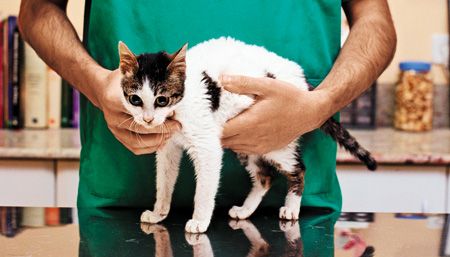Lecture Link: Diagnosing and treating urinary tract infection in cats
Practical tips for working up and treating cats with urinary signs.

In his presentation "Diagnosing and treating urinary tract infection in cats,” at the 2015 CVC in Washington, D.C., Dennis Chew, DVM, DACVIM, discussed the latest developments concerning feline urinary tract infections (UTIs), offering practical tips for working up and treating cats with urinary signs.
Prevalence
Because of sophisticated urinary tract defense systems, cats contract bacterial UTIs much less commonly than once suspected: About 1% to 3% of cats within their lifetimes are affected. Idiopathic/interstitial cystitis accounts for 60% to 70% of diagnoses of cats with urinary urgency.
Cats with confirmed bacterial UTIs most often have concurrent anatomical, metabolic or functional problems of the bladder or urethra, or they have undergone an invasive procedure such as urethral catheterization. Metabolic diseases over-represented in cats with UTIs include chronic kidney disease, hyperthyroidism, and diabetes mellitus. Increasing age was also found to be a significant risk factor for UTIs in female cats with chronic kidney disease in one study.1
Diagnosis
A UTI may be confirmed with various combinations of hematuria, pyuria and bacteria in urinary sediments in a patient with lower urinary signs and a positive, quantitative urine culture result. Since many urinary sediment particles in cats resemble bacteria, dry-mount examination of sediment after either Wright's-Giemsa or Gram's staining is recommended.
The gold standard for a definitive diagnosis in cats remains isolation of organisms in large quantitative growth (cfu/ml) from a properly collected and handled sample. A true bacterial UTI is likely when ≥ 1,000 cfu/ml of organisms are isolated from urine collected by cystocentesis. Contamination is more suspected in isolates < 1,000 cfu/ml, although in patients with increased voiding frequency, lower cfu/mls are often clinically significant, as organisms may be eliminated from the bladder before replicating extensively.
Escherichia coli and Enterococcus, Staphylococcus, Streptococcus, and Proteus species are common organisms isolated from the urine of infected cats. A rare form of recurrent UTIs, encrusting cystitis, is an infection by Corynebacterium species amid encrustations of struvite crystals within bladder tissue. Diagnosis requires extended periods of growth and special media for culture.
Treatment
Treatment based on antibacterial susceptibility remains the gold standard, with antibacterial drugs that are likely to be effective against more than 90% of isolates most recommended. Further guidelines have been compiled by the Working Group of the International Society for Companion Animal Infectious Diseases (ISCAID). More details may be found at hindawi.com/journals/vmi/2011/263768.2
Treatment is not currently recommended for asymptomatic cats with isolates of Enterococcus species, as this infection commonly resolves without intervention. Antimicrobials should be given not just for seven to 14 days, but until a bacteriologically sterile urine can be confirmed both during administration of medication and for a protracted time after cessation of treatment.
References
1. White JD, Stevenson M, Malik R, et al. Urinary tract infections in cats with chronic kidney disease. J Feline Med Surg 2013;15:459-465.
2. Weese JS, Blondeau JM, Boothe D, et al. Antimicrobial use guidelines for treatment of urinary tract disease in dogs and cats: antimicrobial guidelines Working Group of the International Society for Companion Animal Infectious Diseases. Vet Med Int 2011; Article ID 263768.
David Kovalik, DVM
Union Veterinary Clinic
Washington, D.C.